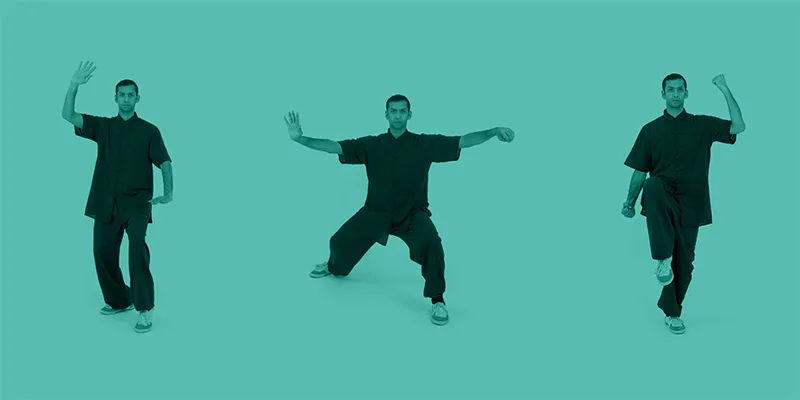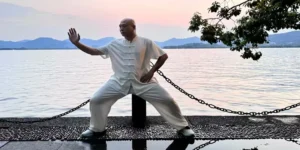
What Is Tai Chi 8 Form?
Tai Chi 8 Form, also known as yang 8 step tai chi, refers to a standardized Tai Chi for beginners routine developed by the State Sports Commission of China in the late 1990s. Tai Chi 8 Form is a simplified movement derived from Yang style Tai Chi while also incorporating common motions from other styles.
How To Learn Tai Chi 8 Forms?
The First of Tai Chi 8 Forms: Commencement (Qi Shi)
Begin standing upright, feet parallel and shoulder-width apart. Arms hang naturally. Initiate movement by slowly raising both arms forward and upward to shoulder height, palms facing down, coordinated with a slight knee bend and sinking of the body. Then, gently lower the arms back down to the sides while straightening the knees slightly, returning to a state of calm readiness. Breathing is natural; inhalation often accompanies rising arms, and exhalation with lowering.
The Second of Tai Chi 8 Forms: Parting the Wild Horse’s Mane (Ye Ma Fen Zong)
From a centered stance, shift weight fully onto one leg, turning the body and stepping out at a 45-degree angle with the other foot into a bow stance. Simultaneously, the arm on the stepping side (left) arcs upward and forward across the body to approximately forehead height, palm facing diagonally inward (Peng). The opposite arm presses downward and slightly outward to hip level, palm down. The movement is repeated symmetrically to the other side.
The Third of Tai Chi 8 Forms: White Crane Spreads its Wings (Bai He Liang Chi)
Following Parting the Wild Horse’s Mane, shift weight fully back onto the rear leg (right), lifting the front foot (left) slightly and turning the body to face forward. Settle into an Empty Stance (Xu Bu) with most weight (70-90%) on the rear leg. Simultaneously, one arm, typically the one corresponding to the weighted leg, rises, palm facing forward/faintly inward, positioned near the temple or forehead. The other arm lowers, palm down, near the hip or upper thigh. The posture resembles a crane displaying its wings.
The Fourth of Tai Chi 8 Forms: Brush Knee and Step Forward (Lou Xi Yao Bu)
From an empty stance or centered position, step forward into a bow stance. As the step is made, the hand on the same side as the stepping foot sweeps (“brushes”) downward in an arc across the front of the body, passing near the knee (palm down), deflecting or clearing a low attack. Simultaneously, the opposite hand pushes forward from near the ear or shoulder in a palm strike, coordinated with the weight shift into the bow stance. The movement is typically performed alternating left and right.
The Fifth of Tai Chi 8 Forms: Playing the Pipa (Shou Hui Pi Pa)
From a forward-weighted position, shift weight fully back onto the rear leg, lifting the front foot slightly. Simultaneously, both hands draw smoothly back towards the body. One hand rotates to palm inward near the chest; the other hand (often the brushing hand) rotates to palm inward near the solar plexus or ribs. The hands move as if gently holding and tuning a pipa, elbows slightly dropped and rounded.
The Sixth of Tai Chi 8 Forms: Step Back and Repulse Monkey (Dao Nian Hou)
From a forward stance, step backward with one foot into a bow stance (the rear foot becomes weighted). As the back step is taken, the hand on the same side as the stepping foot circles upward and backward near the ear, palm facing outward/upward. The opposite hand simultaneously pushes forward at chest height, coordinated with the weight shift backward. The head turns to look over the forward hand. Repeated alternating left and right.
The Seventh of Tai Chi 8 Forms: Wave Hands Like Clouds (Yun Shou)
Performed in a continuous, flowing sequence while shifting weight laterally. Begin in a horse stance or shoulder-width stance. Shift weight to one side. The hand on the weighted side lowers across the body. The other hand simultaneously rises, crossing under the lowering arm, palm facing inward. As weight shifts to the other side, the hands reverse roles: the rising hand continues up and over, palm gradually rotating outward, while the other hand lowers across the body. The hands move in smooth, symmetrical arcs like parting clouds, coordinated precisely with lateral weight shifts. Typically performed for 3-6 repetitions.
The Eighth of Tai Chi 8 Forms: Closing Form (Shou Shi)
From the end of Wave Hands, slowly bring both hands down in front of the body, palms facing down, as the knees gently straighten slightly. Hands lower to the sides, returning to the starting Wu Ji posture. Sink the weight evenly. Bring feet together slowly if they were apart. Allow the breath to settle and the Qi to sink to the Dantian.
What Is the Difference 8 Form and 10 Form Tai Chi?

Origin and Purpose:
Tai Chi 8 Form: Attributed to the Chinese Sports Commission or similar bodies in the 1970s/80s. Its primary purpose was health promotion and mass participation. It’s to be extremely accessible; it aims to introduce the fundamental movements, weight shifting, and coordination of Tai Chi to a broad population, including the elderly and those with limited mobility or time. It draws its name (“Ba Duan Jin”) from the famous health qigong set, but the movements are distinct Tai Chi postures.
Tai Chi 10 Form Tai Chi was created much later by the International Wushu Federation (IWUF) specifically for standardized international competition and systematic progression. Its purpose was to provide a clear, standardized beginner’s routine for global wushu (martial arts) competitions that bridges the gap between basic movements and the more complex 16, 24, or 42 form competition routines. It is a martial application within a simplified structure suitable for judging.
Structure and Movement Sequence:
Tai Chi 8 Form: True to its name, it consists of 8 distinct, named postures. The sequence is very short and linear, often performed symmetrically. Transitions are simplified. A typical performance takes 1.5 – 3 minutes.
Tai Chi 10 Form: While named “10 Form,” it actually comprises 10 distinct movement sections, some of which contain multiple classical postures or transitions. It includes core Yang-style movements like Commencement, Grasp Sparrow’s Tail, Single Whip, Wave Hands Like Clouds, High Pat on Horse, Heel Kick, and Closing. It introduces directional changes and more complex transitions than the 8 Form. Performance time is typically 3 – 5 minutes, reflecting its complexity.
Complexity and Martial:
Tai Chi 8 Form: Stances are generally higher and wider for stability. Weight shifts are basic. There is minimal explicit emphasis on martial application; the focus is almost entirely on posture, relaxation, slow movement, and coordinated breathing for health benefits.
Tai Chi 10 Form: It requires more precise weight distribution, deeper stances, clearer distinctions between substantial and insubstantial, and more intricate coordination. Crucially, it explicitly incorporates and emphasizes martial applications within the simplified framework. Movements like Ward Off, Roll Back, Press, Push, and the kicks are performed with clearer intent regarding their defensive and offensive meanings, aligning with its competition purpose.
Standardization and Usage:
Tai Chi 8 Form: While widely taught, it has less rigid international standardization. Variations in the exact execution of movements, timing, and even the specific postures included can exist between different instructors or organizations, as its primary goal is health accessibility, not competition uniformity.
Tai Chi 10 Form: Developed by the IWUF, it is highly standardized globally for competition purposes. There is a single, official sequence with defined technical requirements for each movement section. Judges in international wushu competitions use specific criteria to evaluate its execution. This makes it a consistent benchmark worldwide.
Functional Focus:
Tai Chi 8 Form: Primarily Health and Wellness. Ideal for stress reduction, balance improvement, gentle joint mobility, and introducing Tai Chi concepts with minimal physical demand. Its simplicity maximizes accessibility.
Tai Chi 10 Form: Bridge to Traditional & Competitive Tai Chi. While offering significant health benefits, it explicitly serves as a foundational stepping stone for learning longer traditional forms (like the 108 form tai chi) or standardized competition routines (16, 24, and 42 forms). It prepares practitioners for the technical demands, martial understanding, and performance standards required in the competitive wushu arena.


